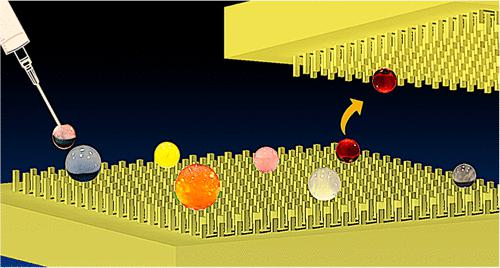Our official English website, www.x-mol.net, welcomes your
feedback! (Note: you will need to create a separate account there.)
3D Printed Parahydrophobic Surfaces as Multireaction Platforms
Langmuir ( IF 3.7 ) Pub Date : 2022-06-10 , DOI: 10.1021/acs.langmuir.2c00788 Julio C Gaxiola-López 1, 2, 3 , Tania E Lara-Ceniceros 1, 2, 3 , Luis Gerardo Silva-Vidaurri 3 , Rigoberto C Advincula 4, 5, 6 , José Bonilla-Cruz 1, 2, 3
Langmuir ( IF 3.7 ) Pub Date : 2022-06-10 , DOI: 10.1021/acs.langmuir.2c00788 Julio C Gaxiola-López 1, 2, 3 , Tania E Lara-Ceniceros 1, 2, 3 , Luis Gerardo Silva-Vidaurri 3 , Rigoberto C Advincula 4, 5, 6 , José Bonilla-Cruz 1, 2, 3
Affiliation

|
Parahydrophobic surfaces (PHSs) composed of arrays of cubic μ-pillars with a double scale of roughness and variable wettability were systematically obtained in one step and a widely accessible stereolithographic Formlabs 3D printer. The wettability control was achieved by combining the geometrical parameters (H = height and P = pitch) and the surface modification with fluoroalkyl silane compounds. Homogeneous distribution of F and Si atoms onto the pillars was observed by XPS and SEM-EDAX. A nano-roughness on the heads of the pillars was achieved without any post-treatment. The smallest P values lead to surfaces with static contact angles (CAs) >150° regardless of the H utilized. Interestingly, the relationship 0.6 ≤ H/P ≤ 2.6 obtained here was in good agreement with the H/P values reported for nano- and submicron pillars. Furthermore, experimental CAs, advancing and receding CAs, were consistent with the theoretical prediction from the Cassie–Baxter model. Structures covered with perfluorodecyltriethoxysilane with high H and short P lead to PHSs. Conversely, structures covered with perfluorodecyltrimethoxysilane exhibited a superhydrophobic behavior. Finally, several aqueous reactions, such as precipitation, coordination complex, and nanoparticle synthesis, were carried out by placing the reactive agents as microdroplets on the parahydrophobic pillars, demonstrating the potential application as chemical multi-reaction array platforms for a large variety of relevant fields in microdroplet manipulation, microfluidics systems, and health monitoring, among others.
中文翻译:

作为多反应平台的 3D 打印准疏水表面
一步系统地获得了由具有双重粗糙度和可变润湿性的立方 μ 柱阵列组成的副疏水表面 (PHS),并且是一种可广泛使用的立体光刻 Formlabs 3D 打印机。通过结合几何参数(H = 高度和P = 间距)和用氟烷基硅烷化合物进行表面改性来实现润湿性控制。通过 XPS 和 SEM-EDAX 观察到 F 和 Si 原子在柱上的均匀分布。柱头的纳米级粗糙度无需任何后处理即可实现。最小的P值导致表面的静态接触角 (CA) >150°,而不管使用的H。有趣的是,关系 0.6 ≤ H此处获得的/ P ≤ 2.6 与报告的纳米和亚微米柱的H / P值非常一致。此外,实验 CA,前进和后退 CA,与 Cassie-Baxter 模型的理论预测一致。高H短P的全氟癸基三乙氧基硅烷覆盖的结构导致小灵通。相反,覆盖有全氟癸基三甲氧基硅烷的结构表现出超疏水行为。最后,通过将反应剂作为微滴放置在副疏水柱上,进行了几种水反应,例如沉淀、配位络合物和纳米颗粒合成,展示了作为化学多反应阵列平台在各种相关领域的潜在应用在微滴操作、微流体系统和健康监测等方面。
更新日期:2022-06-10
中文翻译:

作为多反应平台的 3D 打印准疏水表面
一步系统地获得了由具有双重粗糙度和可变润湿性的立方 μ 柱阵列组成的副疏水表面 (PHS),并且是一种可广泛使用的立体光刻 Formlabs 3D 打印机。通过结合几何参数(H = 高度和P = 间距)和用氟烷基硅烷化合物进行表面改性来实现润湿性控制。通过 XPS 和 SEM-EDAX 观察到 F 和 Si 原子在柱上的均匀分布。柱头的纳米级粗糙度无需任何后处理即可实现。最小的P值导致表面的静态接触角 (CA) >150°,而不管使用的H。有趣的是,关系 0.6 ≤ H此处获得的/ P ≤ 2.6 与报告的纳米和亚微米柱的H / P值非常一致。此外,实验 CA,前进和后退 CA,与 Cassie-Baxter 模型的理论预测一致。高H短P的全氟癸基三乙氧基硅烷覆盖的结构导致小灵通。相反,覆盖有全氟癸基三甲氧基硅烷的结构表现出超疏水行为。最后,通过将反应剂作为微滴放置在副疏水柱上,进行了几种水反应,例如沉淀、配位络合物和纳米颗粒合成,展示了作为化学多反应阵列平台在各种相关领域的潜在应用在微滴操作、微流体系统和健康监测等方面。











































 京公网安备 11010802027423号
京公网安备 11010802027423号